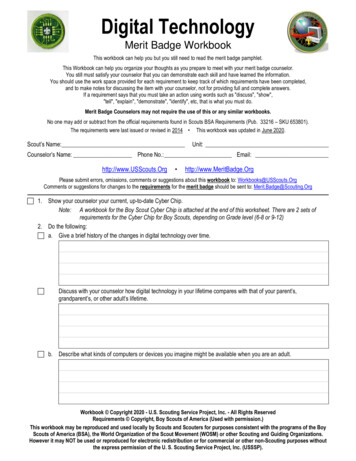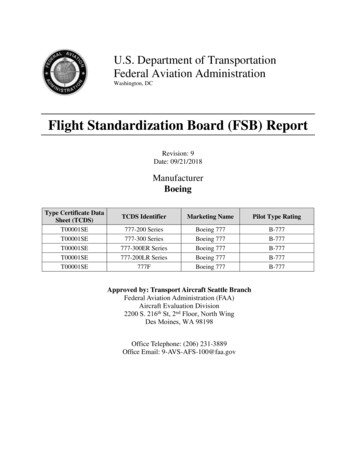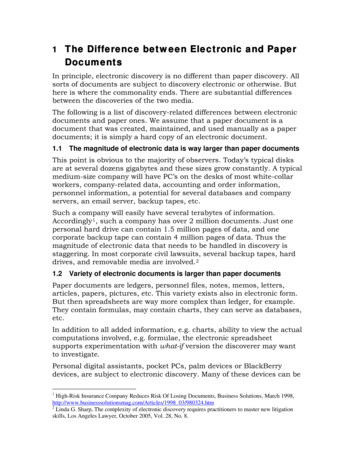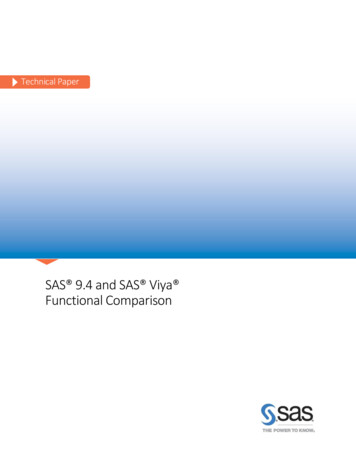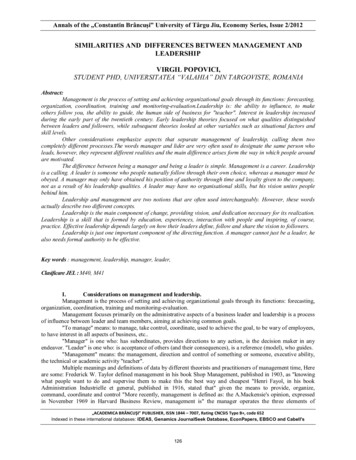
Transcription
Annals of the „Constantin Brâncuşi” University of Târgu Jiu, Economy Series, Issue 2/2012SIMILARITIES AND DIFFERENCES BETWEEN MANAGEMENT ANDLEADERSHIPVIRGIL POPOVICI,STUDENT PHD, UNIVERSITATEA “VALAHIA” DIN TARGOVISTE, ROMANIAAbstract:Management is the process of setting and achieving organizational goals through its functions: forecasting,organization, coordination, training and monitoring-evaluation.Leadership is: the ability to influence, to makeothers follow you, the ability to guide, the human side of business for "teacher". Interest in leadership increasedduring the early part of the twentieth century. Early leadership theories focused on what qualities distinguishedbetween leaders and followers, while subsequent theories looked at other variables such as situational factors andskill levels.Other considerations emphasize aspects that separate management of leadership, calling them twocompletely different processes.The words manager and lider are very often used to designate the same person wholeads, however, they represent different realities and the main difference arises form the way in which people aroundare motivated.The difference between being a manager and being a leader is simple. Management is a career. Leadershipis a calling. A leader is someone who people naturally follow through their own choice, whereas a manager must beobeyed. A manager may only have obtained his position of authority through time and loyalty given to the company,not as a result of his leadership qualities. A leader may have no organisational skills, but his vision unites peoplebehind him.Leadership and management are two notions that are often used interchangeably. However, these wordsactually describe two different concepts.Leadership is the main component of change, providing vision, and dedication necessary for its realization.Leadership is a skill that is formed by education, experiences, interaction with people and inspiring, of course,practice. Effective leadership depends largely on how their leaders define, follow and share the vision to followers.Leadership is just one important component of the directing function. A manager cannot just be a leader, healso needs formal authority to be effective.Key words : management, leadership, manager, leader,Clasificare JEL : M40, M41I.Considerations on management and leadership.Management is the process of setting and achieving organizational goals through its functions: forecasting,organization, coordination, training and monitoring-evaluation.Management focuses primarily on the administrative aspects of a business leader and leadership is a processof influence between leader and team members, aiming at achieving common goals."To manage" means: to manage, take control, coordinate, used to achieve the goal, to be wary of employees,to have interest in all aspects of business, etc."Manager" is one who: has subordinates, provides directions to any action, is the decision maker in anyendeavor. "Leader" is one who: is acceptance of others (and their consequences), is a reference (model), who guides."Management" means: the management, direction and control of something or someone, executive ability,the technical or academic activity "teacher".Multiple meanings and definitions of data by different theorists and practitioners of management time, Hereare some: Frederick W. Taylor defined management in his book Shop Management, published in 1903, as "knowingwhat people want to do and supervise them to make this the best way and cheapest "Henri Fayol, in his bookAdministration Industrielle et general, published in 1916, stated that" given the means to provide, organize,command, coordinate and control "More recently, management is defined as: the A.Mackensie's opinion, expressedin November 1969 in Harvard Business Review, management is" the manager operates the three elements of„ACADEMICA BRÂNCUŞI” PUBLISHER, ISSN 1844 – 7007, Rating CNCSIS Type B , code 652Indexed in these international databases: IDEAS, Genamics JournalSeek Database, EconPapers, EBSCO and Cabell's126
Annals of the „Constantin Brâncuşi” University of Târgu Jiu, Economy Series, Issue 2/2012fundamental -, ideas, things and people -; making the other objectives "Peter Drucker believes that management isequivalent to" people management ", the term" management "is just a euphemism for" chief ". "The main andperhaps the only task is to mobilize energy management unit for meeting known and defined tasks", and test success,says Drucker, is to "achieve high efficiency and adapt to external changes.""A guide (to lead) means: to show the way, method, to influence, to persuade, to model."Leadership" is: the ability to influence, to make others follow you, the ability to guide, the human side ofbusiness for "teacher".Leadership is "the ability to influence some persons and groups, directing their efforts in completingorganizational objectives" [1]We find in everyday life that some people are following others for various reasons known only to them. Ifwe start from a simple example, met in organizing an event, a conference, we find a person holding a series of so called qualities of leadership, can tell others what to do and simultaneously give them respect, but also to earn theirrespect.Great many theories assume that the capacity for leadership is inherent – that great leaders are born, notmade. These theories often portray great leaders as heroic, mythic and destined to rise to leadership when needed.The term "Great Man" was used because, at the time, leadership was thought of primarily as a male quality,especially in terms of military leadership. Learn more about the great man theory of leadership.Similar in some ways to "Great Man" theories, trait theories assume that people inherit certain qualities andtraits that make them better suited to leadership. Trait theories often identify particular personality or behavioralcharacteristics shared by leaders. If particular traits are key features of leadership, then how do we explain peoplewho possess those qualities but are not leaders? This question is one of the difficulties in using trait theories toexplain leadership.Interest in leadership increased during the early part of the twentieth century. Early leadership theoriesfocused on what qualities distinguished between leaders and followers, while subsequent theories looked at othervariables such as situational factors and skill levels. While many different leadership theories have emerged, mostcan be classified as one of eight major types:Contingency theories of leadership focus on particular variables related to the environment that mightdetermine which particular style of leadership is best suited for the situation. According to this theory, no leadershipstyle is best in all situations. Success depends upon a number of variables, including the leadership style, qualities ofthe followers and aspects of the situation.Situational theories propose that leaders choose the best course of action based upon situational variables.Different styles of leadership may be more appropriate for certain types of decision-making.Behavioral theories of leadership are based upon the belief that great leaders are made, not born. Rooted inbehaviorism, this leadership theory focuses on the actions of leaders not on mental qualities or internal states.According to this theory, people can learn to become leaders through teaching and observation.Participative leadership theories suggest that the ideal leadership style is one that takes the input of othersinto account. These leaders encourage participation and contributions from group members and help group membersfeel more relevant and committed to the decision-making process. In participative theories, however, the leaderretains the right to allow the input of others.Management theories, also known as transactional theories, focus on the role of supervision, organizationand group performance. These theories base leadership on a system of rewards and punishments. Managerial theoriesare often used in business; when employees are successful, they are rewarded; when they fail, they are reprimandedor punished. Learn more about theories of transactional leadership.Relationship theories, also known as transformational theories, focus upon the connections formed betweenleaders and followers. Transformational leaders motivate and inspire people by helping group members see theimportance and higher good of the task. These leaders are focused on the performance of group members, but alsowant each person to fulfill his or her potential. Leaders with this style often have high ethical and moral standards.Theorists in the field have associated from the beginning the leadership with the capacity of a person tolead, existing in this sense four true statements:a. To lead you have to influence others.b Where there are leaders there are people who follow them.c Leaders tend to come forth especially in times of need.d Leaders always know what they want to achieve and why.A first conclusion that has to be remebered is that leaders have and should have skills to influence beliefsand feelings of others.„ACADEMICA BRÂNCUŞI” PUBLISHER, ISSN 1844 – 7007, Rating CNCSIS Type B , code 652Indexed in these international databases: IDEAS, Genamics JournalSeek Database, EconPapers, EBSCO and Cabell's127
Annals of the „Constantin Brâncuşi” University of Târgu Jiu, Economy Series, Issue 2/2012Being a leader is a personal thing, but not all managers can be leaders or all leaders can be managers.Things are better made by managers and good things are made by leaders.It is undeniable that the terms management and leadership are highly interrelated, very often being usedinterchangeably. Concerns about explaining and understanding the phenomenona of leadership have emerged in theearly 1900s, the first studies of L.M.Terman (1904) on the characteristics of successful leaders.In terms of the first concerns about the phenomenon of leadership, they focused on personal characteristicsof successful leaders, continuing listing the functions and activities that the leader meets.Nowadays, the phenomenon of leadership is appreciated as a complex group dynamics process, meaning adynamic process of organizing and coordinating a group, in a specific organizational context in order to undertaketasks or goals. For example, the phenomenon called leadersip manifested mainly in the army (Alexander the Great,Genghis Khan, etc.), or in communities in certain circumstances (Moses), religious (Jesus, Buddha, Mohammed,etc.). And today is manifested in different areas: state politics, sport, business etc. The main area in which themanifestation of lidership is wanted is business. In the activity of an organization they met with the conclusion thatthe implications of the phenomenona "TEAM" and "LEADER" brings about a superior performance. Managers wantto win also the title of leader. Note the two labels: manager and leader. They are found in any organization wherethere is a hierarchy. Manager vs. Leader.In this context, leadership as a phenomenon automatically assumes and exercises influence and includesthese two processes: leadership and management.Some approaches consider that these two processes overlap, meaning that they can be assimilated to thenotion of leading, leadership and management reflecting the same meaning.Other considerations emphasize aspects that separate management of leadership, calling them twocompletely different processes.The words manager and lider are very often used to designate the same person who leads, however, theyrepresent different realities and the main difference arises form the way in which people around are motivated.Goals, arguments, methods used by the leaders were very different. We notice a common attribute:persuasion - its ability to persuade and influence. Therefore most discussions on this topic are on the origin of thephenomenon: native or acquired.Here the opinions are divided. Some consider this ability as obviously native; others say you can learn howto be a leader.In the view of P. Drucker, "Leadership is the ability to raise human vision to a broader horizon, to bring theefficiency of human activity to higher standards and also the ability to form personalities, transcending beyond itsusual boundaries that limit it”. [2]II.Classifications of managers and qualities of a good manager .The need for good managers is not going away. It is intensifying. With ‘flatter’ organizations and selfdirected teams becoming common; with personal computers and networks making information available to morepeople more quickly; the raw number of managers needed is decreasing. However, the need for good managers,people who can manage themselves and others in a high stress environment, is increasing.Ask anyone and they'll tell you. There's a difference between managers and leaders. The difference betweenbeing a manager and being a leader is simple. Management is a career. Leadership is a calling.You don't have to be tall, well-spoken and good looking to be a successful leader. You don't have to havethat "special something" to fulfill the leadership role.What you have to have is clearly defined convictions - and, more importantly, the courage of yourconvictions to see them manifest into reality. Only when you understand your role as guide and steward based onyour own most deeply held truths can you move from manager to leader.A leader is someone who people naturally follow through their own choice, whereas a manager must beobeyed. A manager may only have obtained his position of authority through time and loyalty given to the company,not as a result of his leadership qualities. A leader may have no organisational skills, but his vision unites peoplebehind him.Managers think incrementally, whilst leaders think radically. "Managers do things right, while leaders dothe right thing.". [3]This means that managers do things by the book and follow company policy, while leaders follow their ownintuition, which may in turn be of more benefit to the company. A leader is more emotional than a manager . "Menare governed by their emotions rather than their intelligence" . [4]This quotation illustrates why teams choose to follow leaders.„ACADEMICA BRÂNCUŞI” PUBLISHER, ISSN 1844 – 7007, Rating CNCSIS Type B , code 652Indexed in these international databases: IDEAS, Genamics JournalSeek Database, EconPapers, EBSCO and Cabell's128
Annals of the „Constantin Brâncuşi” University of Târgu Jiu, Economy Series, Issue 2/2012In the commercial companies from our country and the state administrated companies we diferentiate duringthe current period three types of managers:- Authoritarian Manager that emphasise on hierarchical relations of subordination, and secondarily on thedelegation and consultation with subordinates, sometimes to mask some gaps in training.The decrease in initiative and creativity is dued to the pleasure of exercising the granted powers, combinedwith a certain lack of understanding and friendly approaching the subordinates.- Participatory managers require tact and attachment; they are well trained in management, but also in the groupactivity area, easily establishing human contact. They place great emphasis on providing a relaxed workenvironment, suited to positive personal development of subordinates.- Participatory-authoritarian manager is formed by combining the other two types of managers. During the transitionto a market economy in the commercial companies and state administrated companies, this type of leader is mostcommon.A good leader uses all three styles, depending on what forces are involved between the followers, the leader,and the situation. Some examples include:-Using an authoritarian style on a new employee who is just learning the job. The leader is competent and a goodcoach. The employee is motivated to learn a new skill. The situation is a new environment for the employee.-Using a participative style with a team of workers who know their job. The leader knows the problem, but does nothave all the information. The employees know their jobs and want to become part of the team.-Using a delegative style with a worker who knows more about the job than you. You cannot do everything and theemployee needs to take ownership of her job! In addition, this allows you to be at other places, doing other things.-Using all three: Telling your employees that a procedure is not working correctly and a new one must be established(authoritarian). Asking for their ideas and input on creating a new procedure (participative). Delegating tasks in orderto implement a new procedure (delegative).While there are several Team Leadership models, Hill's Team model is perhaps one of the better knownones as it provides the leader or a designated team member with a mental road map to help diagnose team problems,and then take appropriate action to correct team problems. [5]This Team Leadership model is built on a number of research projects:After the general features of the responsibilities fulfilled, managers can be:- Senior managers (top managers, senior managers);- Middle managers;- First line managers (supervisors);- Populist manager which is characterized by:Populist managers lack a strategic management; turn to large loans in order to solve some wagerequirements, but which result in, violation of fundamental correlations between economic indicators (productivity,average wage).Authoritarian managers have a strong personality and authoritative experience, he is correct, severe, strict,serious in fornt of the employees, pays special attention to problems of restructuring but is uninterested in socialissues, he agrees with resignation in case it is impossible for him to exercise his managerial style and aims tomaximize profit,The incompetent manager is relatively corruptible, does not have a realistic strategy, lacks initiative andcourage to take risks, dissatisfies everyone and manifests inadaptability to ambient changesIn contrast with the incompetent manager, the participatory- reformist manager believes that restructuring ispossible on the go by providing a partnership of employees, demonstrates an innovative spirit, creative, courageousin taking risks, high capacity to lead, flexibility in situations of crisis or conflict to which he adds preventivemeasures to avoid them. Conciliatory manager has skills in conflict situations, compromising between the two trendsconsidered comments, has survival strategies and skillful leadership, from day to day and achieves averageperformances in both cases;The leading task is defined as a complex activity that aims to the improvement of people’s efforts in thework process. Exercising the management process requires the existence of persons who carry out managementprocess specific activities, these people are called, managers.There are different opinions regarding the definition of a manager (management framework).P.Drucker believe that their managers are so-called leaders and specialists and others who make decisions toinfluence the enterprise activity, except it but the foreman. P.Bolinet says a leader is a person who get results throughothers.„ACADEMICA BRÂNCUŞI” PUBLISHER, ISSN 1844 – 7007, Rating CNCSIS Type B , code 652Indexed in these international databases: IDEAS, Genamics JournalSeek Database, EconPapers, EBSCO and Cabell's129
Annals of the „Constantin Brâncuşi” University of Târgu Jiu, Economy Series, Issue 2/2012In a unanimously accepted definition by most specialists, the manager (management framework) is definedas the person who occupies a leadership position in a socio-economic organization, regardless the hierarchical level.In terms of managing an enterprise, it is defined as the person who acts to transform tasks into concreteactions for efficient use of enterprise resources and profit growth, to mobilize and motivate employees in their workprocess.There are two categories of requirements requested to the manager.A. Requirements relating to personality.Personality involves two sides.A. instrumental side – given by skills that are themselves of two kinds:· work in developing leadership: flair, intuition, spontaneity, communication skills, decision making, ability tomanage people, desire to lead.· basic job-related skills which, if they exist, ensure the acquisition of professional competence;B. operative act – given by: temperament and energy resources; character.Personality is a result of four factors: physical environment (climate, food); the social environment (land, family, education); constitution and temperament of the subject; habits and skills gained under the effect of previous influences (lifestyle, food hygiene);This represents the manner of expression of personality in the relationships of men with the environmentand himself, manner that is adjusted by social norms of behavior in social- historical systems.These items related to health, vigor, skill, energy, balance, self-control, imposed by the necessity ofanimation of the subordinates in work and maintaining a relaxed work environment.III. Requirements relating to intellectual qualities.Not just once, practice in management area has shown that, manager effectiveness depends on highintellectual potential, the knowledge of principles, methods and management techniques that are acquired throughlearning, but aslo innate positive character traits.These are: intelligence, ability to recognize, accept and apply the new, ability to think clearly, memory,imagination, ability to predict, practical thinking (for solving current problems), theoretical thinking forgeneralization and abstraction.Types of managers and management styles.According to Swiss psychologist Carl Jung, there are two human types:a extraverts - people opened to the outside world, sweeping, outward, in which objective tendencies prevail;b introverts - internalized people, deepened in their own world, meditative, reserved, in which subbjective tendenciesprevail;This polarization of human types is varied by intermediate types. You can specify in this respect thefollowing human types:a Balanced - meditative but energic people, adaptable but with reservations, open to the outside world, but thefiltered by introspection. Balanced people are the prototype of the leader.b Compensated - people to which the types of extroverted and introverted can only temporarily coexist, alternatingwith a certain periodicity. People in this category accumulate facts, observations, meditate on them, drawconclusions and verify them.They represent the type of creator.Human type managers manifest themselves daily by management style.We distinguish the following:a. participatory democratic style in which we establish: concern for business objectives without neglecting theproblems of subordinates, ease in establishing and maintaining human contact, broad delegation of authority,responsibility, tact, kindness, attachment;b. autocratic style represents the negative of the style above: no consultation, placing forefront the formal authority,lack of trust in subordinates, lack of delegation, excessive control and guidance;c. participative - authoritative style, frequently met, presents characteristics from both styles presented.d. An excellent manager observes skills, talents most deeply hidden of a person and tries to highlight them to makeeach person exceed its limits.e A remarkable manager sees the potential of others and has to sum up a series of essential features such as:„ACADEMICA BRÂNCUŞI” PUBLISHER, ISSN 1844 – 7007, Rating CNCSIS Type B , code 652Indexed in these international databases: IDEAS, Genamics JournalSeek Database, EconPapers, EBSCO and Cabell's130
Annals of the „Constantin Brâncuşi” University of Târgu Jiu, Economy Series, Issue 2/20121. Structuring. A manager must surely set the parameters, reference rules and content parameters and the structure inwhich we work, and these limits to not affect the activities or projects and must know how to work within thesestructures.2. Creativity. The difference between competent and excellent is and must be precisely through this feature.Creativity represents the "spark" that propels projects and attracts attention of others, but also it’s the "ingredient"that unites different parts to become a whole.3. Intuition. Intuition can be defined as the capacity of knowing without using rational thought process, but also thefundamental basis of emotional intelligence. More the intuition is developed, more the manager is stronger.4. Commitment. A manager must undertake to ensure successful completion of a project or ensuring the success ofthe team as a whole. For this he must have vision over the project and to coordinate the team result.5. Knowledge. An essential for anyone is basic knowledge. For a manager, the knowledge about the business mustbe fully integrated to become part of their being. Thus, the manager can focus on employee developmentopportunities to reach the same level of understanding of the process, but also on its needs, living in the light ofknowledge.6. Flexibility. It is one of the most valuable qualities of a manager and requires openness, openness that gives themanager the ability to adapt quickly to need.7. Humanity. Managers close to the employees are valued by them, but also those who do not disdain to bethemselves in front others. Employee loyalty is a certainty for managers when the latter complies and creates a closeand friendly relationship with the employee.8. Discipline. By discipline is meant the ability to choose and to live from the things that we care.Discipline asautoinduction can be fun, but it is one of the most important traits of a manager.9. Relaxation. An excellent manager not only produces excellent results for the company, but also has some fun inthe process. A state without too much conflict, relaxing, helps the team move forward in achieving goals.10. Overview, details. An excellent manager will always have a very good overview, but at the same time, will beable to execute the small details of a project.Small details create a bigger picture. A manager will be able to do both:to think for the future, but be careful and to present details.Tabel nr.1PSIHOSOCIOPROFESIONAL MANAGER PROFILE 6.7.REQUESTS1PreparationProfessionalManagement scienceEconomic knowledgeLegal knowledgeKnowledge of administrationKnowledge of psychologyExperienceThe unit profileLeadingPsychological qualitiesGeneral intelligenceFlexibility of thoughtCreative capacitySocial value motivationPositive characterologicaltraitsWillfully qualitiesStrong temperament xxxxxxxxxxxxx„ACADEMICA BRÂNCUŞI” PUBLISHER, ISSN 1844 – 7007, Rating CNCSIS Type B , code 652Indexed in these international databases: IDEAS, Genamics JournalSeek Database, EconPapers, EBSCO and Cabell's131
Annals of the „Constantin Brâncuşi” University of Târgu Jiu, Economy Series, Issue 2/2012balancedIV.Behavior1.Sociabilityx2.Fluent speakingx3.Correct posturexHealth StatusxV.1.GoodxIV.Lideship Function.Leaders: Born or Made?This is the most basic and most often-asked question about leadership. To cut to the chase, the answer is:„mostly made.'’The best estimates offered by research is that leadership is about one-third born and two-thirds made.The job of leading an organization, a military unit, or a nation, and doing so effectively, is fantastically complex. Toexpect that a person would be born with all of the tools needed to lead just doesn't make sense based on what weknow about the complexity of social groups and processes.The fact that leadership is mostly made is good news for those of us involved in leadership development leaders can indeed be developed. Yet, there is some "raw material," some inborn characteristics, that predisposepeople to be and become leaders. What are some of the inborn qualities? A leader may not always be a manager.Often with small groups, it is not the manager who emerges as the leader. In many cases it is a subordinatemember with specific talents who leads the group in a certain direction. "Leaders must let vision, strategies, goals,and values be the guide-post for action and behaviour rather than attempting to control others." [6]A lot has been said about leaders and managers in literature and more has been written.F.W. Taylor has studied and analyzed deeply and systematically lidership but without reaching a commonground on the notion of leaders and the method of studying this notion.Leadership is one of the five functions of management. [7]Through his research started in the 50s, F.Fiedler, whose concerns focused on the leading style, showedhow leadership practice is strongly influenced by situational context and the effectiveness of group activity isconditioned by the personality of the leader and the context gives the leader enough power to control.For the two terms of the relationship leader-situation, Fiedler proposes the following measures:1. The personality of the leader, expressed by "note the least favorite fellow-laborers", which outlines on the basis ofa questionnaire a leader’s feedback to the subordinates with whom he does not want to work with.The leader who can favorably appreciate subordinates, giving them a high grade, practice a people orientedleadership, in other words based on close impersonal relationships with subordinates and without giving muchattention to the adverse effects that the least favorite subordinates have on group performance. Instead, the leaderwho grades low the least favorite subordinates is task oriented and aims to fullfill them at the risk of strainedrelationships with some subordinates;2. The situation, classifies through three factors: leader-subordinate relationships, power leader position, iethe extent to which he can demand from the subordinates to accept his provisions (which depends on the rewar
SIMILARITIES AND DIFFERENCES BETWEEN MANAGEMENT AND LEADERSHIP VIRGIL POPOVICI, STUDENT PHD, UNIVERSITATEA "VALAHIA" DIN TARGOVISTE, ROMANIA . determine which particular style of leadership is best suited for the situation. According to this theory, no leadership style is best in all situations. Success depends upon a number of variables .
